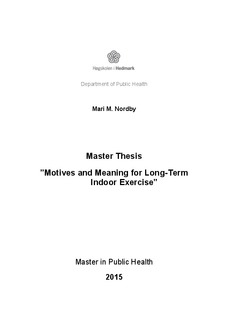”Motives and Meaning for Long-Term Indoor Exercise"
Master thesis

Åpne
Permanent lenke
http://hdl.handle.net/11250/2368593Utgivelsesdato
2015Metadata
Vis full innførselSammendrag
English abstract: This qualitative study was designed to explore the motives and what gives meaning (is
pleasure something meaningful) to Norwegian people who maintain for a long time regular
indoor exercise regime. There are few studies on this phenomenon in Norway. The theory of
hedonism in exercise informed this study. Six long-term adhering exercisers (three men and
three women) were interviewed about their exercise experiences and feelings of pleasure and
displeasure when exercising indoor. A phenomenological approach was used for designing
and implementing the study and a thematic analysis was performed to analyze the information
gathered. Several elements about a regular exerciser’s motives and meaning were identified
and organized within five themes: one’s exercise habits, ways to overcome barriers, choosing
own exercise, the exercise environment, and the exercise induced affect. All participants had a
goal that helped them exercise on a regular basis; with health and fitness level goal or high
performance goal, yet the goal was there. All participants also had developed a high level of
self-awareness regarding their bodies and of knowledge regarding exercise types and
intensities. Concerning the meaning of the experience and the role of pleasure in it, five of the
six participants in this study highlighted the important of pleasure during exercise. To
experience the desired pleasure the exercisers select on their own the exercise intensity
considering their mental and physical state for the day and time being. Earlier exercise
experiences appear to play a positive role for the adherence the exercisers experience today.
Last but not least, the participant shared that while they feel pleasure in the exercise
environment, sometimes social pressure pushed them to do things differently like increase
their exercise intensity in the presence of others. These findings are discussed in relation to
the recommendations for physical activity levels provided by the Norwegian government,
which are clear and suggest that people need to get more physically active. While this is a
qualitative study and its findings should be generalized, as people come into the fitness
centers with different experiences and goals, some suggestions are offered for the fitness
practitioner who ought to help clients find pleasure in the act of exercise in order to achieve
exercise adherence.